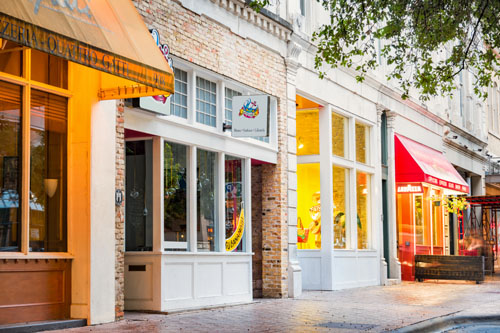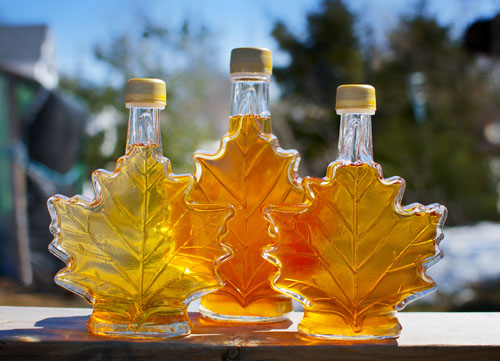Introduction
You’ll begin this learning activity by learning what marketing means, ultimately understanding that marketing is a combination of many different activities, such as advertising, packaging, and branding. You’ll discover how these activities come together in the marketing mix and how the marketing mix affects the success (or failure) of retail stores and other service businesses.

As you continue within this unit, you’ll focus on each of the four parts of the marketing mix and their importance to retailing.
To illustrate these concepts, you will follow the development of a fictitious retail business, called “Presents,” learning how the owner applies each part of the marketing mix to her enterprise.
What you will learn
After completing this learning activity, you will be able to
- list and describe eleven marketing activities
- provide examples of products and services
- discuss the importance of various pricing policies to different retail stores
- describe the effectiveness of various promotional techniques
- identify the four parts of the marketing mix and describe how they influence marketing activities
- describe the types of products offered by retail and service businesses
What is a business?

To understand marketing, you first need to understand what a business is and how it functions. What makes a business successful?
Study each of these business examples, considering what they have in common.
- An Ontario maple syrup producer makes her product on site, selling it each day for a small profit. She is successful because people love the flavour of her syrup, particularly with breakfast products.
- A maple syrup manufacturer buys the raw, unprocessed tree sap after it has been produced in sanitized containers. The factory’s expenses total $40,000 each week during production season. Since people want maple syrup, the factory can charge stores across North America $50,000 per week for its product.
- The maple syrup producers and manufacturers hire transport companies to ship the sap or the syrup to where it is needed. The transport company doesn’t make or grow things to sell; instead it sells its services for profit.
- Stores and supermarkets across North America buy the maple syrup from the manufacturers and make a profit as well. Like the transport company, the stores and supermarkets don’t manufacture the products they sell (with some exceptions, such as stores that have bakeries); they provide services (buying, selling, storage, distribution, and so on).

Did you notice that there are some common words that apply to each of these businesses? For example, all businesses sell things. Two of the four businesses make the things they sell, whereas the other two businesses sell the services they provide. What else do they have in common?
Each business satisfies the wants or needs of a group of consumers, or else they would not be in business. They each sell their products and services for more than it costs to make them.
When a business sells goods or services for more than it costs to make them, it makes a profit.
What is the purpose of a business?
A business makes or sells products or services to satisfy the wants and needs of consumers and make a profit.
Scenario: Presents
“Presents” is an independent gift store located in Sarnia, Ontario. Presents buys products such as soap, coffee mugs, picnic baskets, and greeting cards from manufacturers or distributors, and then resells them to their customers. It is much easier for a person who wants a card for a special occasion to buy one at Presents than it is to travel to Montreal, Quebec, where the greeting card is made.

Businesses can exist only if they satisfy the needs and wants of their customers, while making a profit.
Profit is created when a business sells its products or services for more than it costs to make or provide them.
It costs Presents $700 for the goods that the store sold on Saturday. It also costs Presents $400 to cover its overhead (the daily costs of doing business, such as rent, utilities, wages, etc.) on Saturday. If Presents made $1,400 in revenue (sales) on Saturday, how much profit did they make on Saturday? If you’re not sure, take a guess.
Scenario debrief: Presents
Presents made $300 in profit on Saturday. This image shows how their profit is calculated:

Saturday is the store’s busiest day. Therefore, Presents is not likely to make the same profit on other days. In fact, on a very slow day they may experience a loss instead of a profit. On average, Presents makes a $1,000 profit each week. Making a profit is why businesses exist. Owning a business is a hard and often financially risky job. Business owners must receive some reward for their risk and long working hours. Profit is that reward.
How is a business structured?
There are five functions of a business which typically exist as unique divisions or departments within a medium-sized business. These include the following
What is marketing?
Have you ever wondered how you can use maple syrup at breakfast that was, only weeks earlier, in a tree in Central Ontario? It is marketing that gets it to your breakfast table. However, marketing is not just one thing. It can be many things.

Buying a selection of ties for your menswear store is a marketing activity. Studying your competition to see what style of ties they carry is also a marketing activity. Advertising your new ties is marketing as well. Approaching a customer to show him how great one of the new ties looks with his new suit – that’s marketing too. In fact, anything you do to try to get a product or service from the business that produces it to the person (or business) that uses it is a marketing activity.
Marketing is the total of all the activities involved in getting goods and services from the original producer to the ultimate consumer, including you.
Explore the following video for a brief introduction to the concept of marketing.
Marketing activities at Presents
Here are just some of the ways that store owner, Pam, demonstrates key marketing activities at her gift store, Presents:
| Marketing activity: | Demonstrated at Presents by: |
|---|---|
| Pricing | Pam recognizes that big box stores may order thousands of boxes of candles and so the manufacturer may give them a substantial discount that it does not provide to a small store like Presents. |
| Branding | Pam stocks some well-known names that are difficult to find in smaller communities such as hers. She does this to entice customers who have a loyalty to particular brands into her store. |
| Packaging | Pam places a customer’s purchase in another package; a box or bag with the store’s name on it. |
| Advertising | Pam buys a quarter-page ad in the local newspaper at least twice a month, which costs about $1,000. She feels that advertising attracts both local residents and new customers who are visiting the area. |
| Selling | Pam appreciates the visits that sales reps make when they have insights or something new to show her. She sees each one about once a month. She deals with nearly 30 suppliers, so six or seven salespeople may make appointments with her each week. |
| Transportation | Pam has coffee mugs delivered to Presents from London, England. |
Now, consider some of the additional marketing activities that Pam fulfills at her gift store, Presents.
What are retail services?
In this course, you will focus on retail and service marketing, which are somewhat different from industrial marketing. Industrial marketers are interested in selling products to other businesses. For this reason, it is often called business-to-business (B2B) marketing. The majority of marketing activities take place in the B2B sector because there are more business-to-business transactions that require marketing activities than business-to-consumer transactions.
Consider an example using orange juice:
- farm equipment companies, seed companies, fertilizer companies and other agricultural firms market their products to the orange grower
- packaging businesses, machine manufacturers, refrigeration companies, and others target the orange juice manufacturer
- the orange juice manufacturer targets the stores
But, in addition to the stores, the orange juice manufacturer also targets the consumer.
It is a two-pronged approach to marketing, and most major brands market their products this way: selling to both the retail stores and the consumer. When a company like a large orange juice manufacturer sells its orange juice to a major grocery store, this is B2B marketing. When the manufacturer advertises its orange juice to the consumer in magazines or on television, it is business-to-consumer (B2C) marketing.
Retail marketing is primarily B2C while service marketing is often both B2B and B2C. Service businesses that provide personal care and entertainment are B2C services; service businesses such as advertising agencies and transportation companies are B2B. Many provide services to both groups: food and accommodations services, for example, market to both the business traveller and the tourist.

The service industry
Service industries make up the largest and fastest-growing sector of the Canadian economy (the other two are primary industries, such as agriculture and forestry, and secondary industries, such as manufacturing or processing). Service industries (also known as tertiary industries) do not produce things, they perform activities. These are intangible items that you can’t touch or see. Services are things you experience or see the result of, such as a neck massage or a haircut. Paying $10 for admission to an art gallery provides you with the opportunity to see the paintings and sculptures that are there, but you can’t take any of them home.

The following is a partial list of services that businesses (and governments) provide:
- transportation
- warehousing
- cultural industries (museums, art galleries)
- finance (banks, investment companies, insurance companies)
- real estate, including rentals
- technical services
- food services
- arts, entertainment, and recreation
- health care
- personal care
- education
- public administration (government services)
- repair and maintenance
- retail trade
Can you think of any more?
The retail sector
You may have realized that retail trade is only one part of the enormous service industry. Stores provide a service to both consumers and businesses. Retailers provide a distribution outlet for the goods that manufacturers and importers sell and are a source of those goods for consumers. They bring the buyer (consumer) and seller (chocolate bar manufacturer) together. Imagine how difficult it would be for both businesses and consumers if there were no retailers. You would need to go directly to the manufacturer’s plant to get your maple syrup.
Because retailers do not make the products they sell, they are part of the service sector and not the secondary (manufacturing) sector.

The retail-service mix
Many retailers sell extra services as part of their business, just as many service businesses sell products. Some stores sell alterations, extended warranties, and delivery service as well as goods. Others provide restaurant services inside their largest stores.
The more services retailers offer, the better they can compete with similar stores. Sometimes services may even be offered for free. For example, Presents offers a gift-wrapping service at no charge. Many customers comment that they shop at Presents for this reason.
Can you think of two service businesses that sell products as well as services?
Student Alberto’s answer:
The first service business that I can think of that also sells products is a movie theatre. They sell, and make a great deal of profit from, snacks like popcorn and soft drinks. The second would be hair salons, who sell hair care and beauty products on top of providing hair cutting and styling services.
Retail and service businesses are similar in that they both sell directly to consumers. Service is important to both categories when it means looking after customers in a friendly helpful way. How many times have you decided not to shop at a store or eat in a restaurant based on a previous experience that didn’t meet your expectations? Conversely, how many places do you return to regularly because they provide excellent service and you like shopping there? A business can spend thousands, even millions, of dollars to attract you, but it is good service that keeps you coming back.
What is the marketing mix?
The marketing activities you learned about earlier in this learning activity can be summarized in four major categories that combine to form the marketing mix. The term “mix” indicates how important it is for all businesses to blend their marketing activities in the right combination.
The major categories that are always a part of the marketing mix are referred to as the Four Ps and include the following:
Conclusion
You’ve now had a chance to learn the fundamentals of business and marketing. As you’ve seen, there are many different types of businesses and forms of marketing that exist in the retail and service sectors. Next, you will learn about different marketing products and services and the choices that businesses have to make deciding upon what products and services they will carry.



